Written on October 8, 2013
By Tony
in Handguns, NFA, Semi Autos, Suppressors
I remember years ago reading an original Maxim silencer advertisement, and reading through their brochure. One of the things that struck me was the mention that you could fire shotshells through the suppressor just like any other gun.
If you ask online about shooting .22 shotshells through a suppressor, you will be told not to do it. You will be told this for good reason. Firing shotshells through a suppressor is a pretty bad idea. The shot could spread out and cause damage to the baffles, not to mention lead up the suppressor.
Since the Tac-Sol Cascade Ti has a generous through bore (.290″) and is fairly short and made of solid titanium, I figured I would tempt fate and fire some .22 shotshells through the suppressor to see if they worked. I figured I would know right away if they shot or the capsule weren’t clearing the suppressor.
I started out by placing some cardboard 6″ from the muzzle of the gun, and firing. The hole created was .244″ in diameter and uniform. I tried again at the same distance, the the shots were consistently less than .250″. That was good enough for me.
I started out slow, and just fired one shotshell through the can, after inspecting the suppressor and seeing no indications of contact, I fired a magazine full, still no contact. I was limited because I was shooting into the bullet trap in the safe room, so I couldn’t really back up and check out how things sounded or if it effected patterns at all. I hope to get to the range to try some more later in the week.
For now, a short video shooting into the bullet trap.
Written on October 5, 2013
By Tony
in NFA, Suppressors
A few months ago I got my machine-gun, the Reising model 50 in .45 ACP. It wasn’t my first time handling an NFA firearm by any means, but it was the first one I owned.
Interestingly enough, it wasn’t the first NFA weapon I bought. About 3 months before buying the machine-gun, I had paid for a Tactical solutions Cascade Titanium suppressor. I paid the dealer in July, but frustratingly he didn’t file the form3 to transfer to my dealer until the end of October. The can finally arrived at my dealer in December, With all of the holiday merriment and requisite family obligations, I didn’t get to file the form 4 until January.
Fast forward 9 months to early October, and I get a call from my dealer telling me that the 2 stamps I filed in January came in the mail. I went and picked both items up this morning. I made the quick drive to my favorite local range, and spent a little time on the trigger, and burned a little ammo.
The Tactical Solutions Cascade Ti suppressor design is several years old now. It’s a little dated in some ways, but still performs reasonably. The reasons I went with the Cascade Ti were threefold. First, it’s full auto rated. Considering my enjoyment of full auto shooting, I anticipated the future need for any can I would own to be F/A rated. Second, it’s made entirely from titanium, meaning that it can withstand cleaning methods that would literally eat other suppressors for breakfast. Third, it’s rated for magnum rimfire and the 5.7×28 round (although since purchasing mine, the company has changed the rating for newer made cascade ti’s to include the magnum rf’s but exclude the 5.7 and .22 hornet, I assume due to manufacturing changes).
Overall the can seems to be very well made, the machine work looks good and everything is nice and tight. The natural titanium finish works fine for me, but I understand it wasn’t the most popular thing out there.
The real issue that a lot of folks will have with the cascade ti is the fact that it’s a ‘sealed’ can. That means that it isn’t designed to be taken apart for cleaning. This was a concern of mine initially when looking at suppressors, but after researching the cleaning method referred to as ‘the dip’ I decided I didn’t mind a sealed can, as long as it was impervious to that cleaning method. I had no desire to take the can apart to clean it every few hundred rounds anyways.
To be completely honest, when I purchased the cascade ti, I wasn’t hoping for or expecting the quietest suppressor on the market. I was concerned with it being full auto rated, easy to clean (the dip) and being hearing safe or better. I got all of that.
The cascade ti isn’t the quietest can I’ve shot, but it does reasonably well on pistol length barrels, and does very well on rifle length barrels. Being able to shoot without hearing protection is a nice change.
I took a variety of ammo with me to test the suppressor, as well as several hosts.

The Thompson Center Contender G2 was a very good host with it’s 16.25″ barrel. With subsonic ammo, it was pellet gun quiet. I also tried CCI’s ‘quiet’ ammo in the gun, and it was indeed, quieter still.
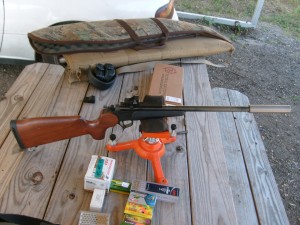
I also brought a Ruger Charger style pistol with me as a host. I had a custom 3.5″ barrel made for the gun, and I still need to do some tuning to get it to cycle 100%, but the barrel length does keep everything but stingers subsonic. using bulk pack winchester the gun was hitting dirt clods at 50 yards without issue. In my rush to get out the door, I forgot to put any optics on the gun, so I wasn’t aiming at the dirt clods as much as pointing at them. still, it was quiet with the can, and probably had as much action noise as anything else.
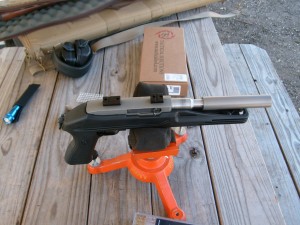
Of course, the S&W 422 pistol with it’s 4″ barrel and high sight line is a natural suppressor host. This gun has proven to be an excellent host for suppressors, the alloy (not zinc!) frame seems to help keep the action noise a little quieter, the 4″ barrel keeps all of the bulk pack ammo subsonic, the sights are visible, even over a suppressor as large as 1.5″ in diameter, and the gun is accurate and easy to shoot. With Standard Velocity Ammo, the combination is very quiet.
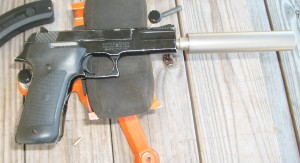
Of course, a day of shooting wouldn’t be complete without some (simulated in this case) full auto fun! The Ruger 10/22 with the Tac-sol X-ring barrel, Kid trigger, Fostech AA2 stock, and of course, the cascade ti. This is where the F/A rating comes in handy, and also why I wouldn’t want to clean it every hundred rounds! You can hear the gun speed up while I’m shooting it in the video, that’s me finding the ‘sweet spot’ for bumping. Since subsonic ammo has less recoil energy, it takes a light touch to make the bumpfire run.
All in all, I am quite pleased with the Tac Sol Cascade Ti. It’s not the quietest can out there, but for me it’s a great compromise between weight, price, ease of maintenance and durability. It’s hearing safe on all of my hosts, and even though there are more .22 suppressors in my future, the Cascade Ti will remain in use for the foreseeable future.
Written on September 18, 2013
By Tony
in Single shot
Today, I’ll talk about a low dollar custom gun that’s been in my safe for several years. I was introduced to the idea of a small Remington action being converted to centerfire and chambered for a low pressure small diameter round some time ago by reading of a project undertaken by Col. Ed Harris. His rifle was a Remington model 580 with a new bolt head and barrel, and chambered in .32 ACP.
Within a year or two of that, I became aware of a Remington model 581 that had been converted to .32 S&W long. The previous owner had given up on the project, and I was able to purchase the gun for very little money.
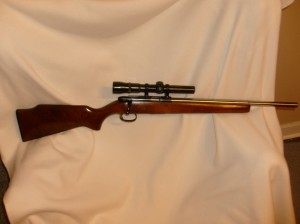
The Remington 540, 580 and 590 series of rifles were significantly overbuilt for the rimfire cartridges they were chambered in. Having 6 locking lugs on the bolt, it’s no wonder that a number of people started converting them to higher zoot calibers. I still buy any that I can find for a reasonable price with an eye toward future conversions.
Back to the rifle at hand. As I mentioned, it was someone else’s abandoned project. Abandoned projects can be anything from awful, to wonderful, depending on the specifics. This one turned out wonderfully. When I received the rifle, it had no throat in the chamber, and poor bedding.
With a little bit of bedding work, and running a throating reamer of the proper diameter into the barrel, I suddenly found myself with a .32 caliber rifle that would put a hole wherever I wanted it to, every time. The gun regularly turns in groups of 1/4″ or less from a rest at 25 yards.
About the rifle: Remington 581 with floating bolt CF conversion, wire extractor, no ejector (makes keeping my brass easier) The rear of the bolt came from a 541 with it’s bent handle. The barrel is 17″ long and cut down from an Argentine Mauser barrel with 4 lands and grooves slugging at .311 in the groove. I size to .313. The barrel is pinned to the receiver with 2 cross pins and 2 set screws. The scope is a vintage weaver steel tube 1.5-4.5x variable with fine cross hairs.
If I was building the rifle myself from scratch, the only thing I would change would be that I would thread the receiver and barrel, and use a Sako type extractor. But beggars can’t be choosers, and with how well the rifle shoots in it’s current configuration, I would never think of messing with it!
Written on September 10, 2013
By Tony
in General Gun Stuff
I probably grumble a lot about technology for someone who makes a living from it, but I really don’t much care for social media and the various social engineering exercises that so many of the people involved with it have resorted to.
Don’t get me wrong, I understand the value to analytics to a marketer, I just don’t like being subversively led into a shearing pen with the rest of the interweb sheep.
Sometimes however, the soc-web can be handy for getting the word out about things. As a result, I have officially started the Youtube “I Own Guns” channel. I haven’t uploaded anything yet, but expect to start seeing videos from time to time as I have the chance to shoot and edit them.
And don’t worry, my goal will be to make every video a gun related video.
At some point in the future, when someone is actually reading this, the link to the channel (that by the time you’re here, should actually have videos) is Here.
Written on August 20, 2013
By Tony
in General Gun Stuff, Product Reviews
I will be doing a review of the Mag Tactical/ Alliance Armament Trident muzzle break soon.
I’m waiting on my AR upper to come back from the gunsmith, and I may do some other stuff with the trident in the mean time.
Watch this space for more!
Written on August 16, 2013
By Tony
in Reloading
I’ve been casting my own bullets for a long time. One of the things about casting bullets, is you’ve got to lube them before you shoot them, or they leave a lot of lead, and kill accuracy. I’ve been using a Star lube-sizer for a long time, along with some other push-through type lubers. The star is pretty much the standard hi throughput bullet lubing machine.
Tonight I had occasion to use an old lyman 450 right after using the star. I had the size die I needed for the Lyman, and didn’t feel like changing the star over, so I lubed with the 450. It was slow. Not like molasses slow, but still so much slower that when I was done, I looked at the pile of freshly lubed bullets, and thought “that took way too long!”
It made me start thinking about the other things that I use that make my life easier. When I started reloading, I had a single stage reloading press. Making 100 rounds of ammo might take me an hour and a half at that point. Now I use a Dillon progressive, and even without case or bullet feeding, I can still load about 400 rounds an hour. I could probably go faster than that, but I don’t like to rush. There’s a difference between rushing and going fast. I like going fast, I don’t like rushing.
I use a loader for 10/22 magazines. It makes loading mags much much faster. It works so well, I want one for every other magazine I have to load regularly. Sadly, they don’t even make that design for the 10/22 anymore.
So, I like things that make life easier. Perhaps more accurately, I like things that make otherwise slow processes faster. It carries over to things outside of the shooting world as well. I like driving a car into town, instead of walking, I like using power tools when building things, I like buying vegies at the grocery instead of growing them myself. Maybe I am lazy.
Written on August 12, 2013
By Tony
in Machine Guns, NFA
When the Reising arrived about 2 months ago, as one might expect, I took it out and shot it. But even before my first range trip, I followed the advice of a fellow reising owner, and modified the firing pin to be inertia style in order to prevent breakage. It did alright the first outing, although it lived up to the poor reliability stereotype.
Each time out, it seemed to get progressively worse. In spite of cleaning the gun to spotless after every outing, it would have frequent jams. I ran through about a dozen different loads, hoping to find the one that would get me some reliability. Almost every jam was the same. The last round chambered would have a light primer strike, but didn’t fire. I surmised that my primers were too hard, and started looking for some federal primers to use. The reason I was looking at different loads was that I was assuming the hammer wasn’t being pushed fully rearward, thus allowing the light strikes from it’s sort of intermediary position.
Before I found any federal primers, my firing pin broke. Frustrated and somewhat disheartened, I ordered a modern and improved replacement from Keystone arms. While I was at it, I ordered a new set of springs.
After installing the unaltered firing pin and new springs, I went to the range, and proceeded to have a jam after 3 rounds. The jam was so bad that I packed the gun up and took it home. When disassembling the gun later that day, I looked and looked, and couldn’t find the reason for my jam. I eventually found a tiny fleck of metal stuck to the bolt, and picked it off. Now the bolt was moving freely again, so I decided to head back to the range. I didn’t expect much.
I took the ammo I had with me, a mix of the various batches I had tried when looking for a reliability load, and loaded up the mags. To my pleasant surprise, when I pulled the trigger, the whole mag went down range, just as I knew it should have been doing since I got it. I inserted the next magazine, and worked the action bar. Brrrrrrrrrrrrrrrrrap! Another successful mag dump! I loaded and dumped until I was completely out of ammo. In 400+ rounds, I only had one stoppage, and that was due to a magazine that I knew had issues. I discovered that all of my loads worked just fine, and with good magazines, the gun would run like a watch!
In the future, when I know I should do some simple maintenance, like changing out springs and a firing pin, I hope I’ll remember the lesson learned here, and just do it from the get go.
If you have a Reising, I highly recommend the Ken Christie firing pin and replacement springs, the difference in my gun was like night and day!
Written on August 10, 2013
By Tony
in General Gun Stuff
Anyone who has been around guns for a while has most likely had something break on them. It’s not surprising, guns deal with pressures that can be measured by the ton per square inch, things moving at thousands of feet per second, and reciprocating parts and springs. Really, when I think about it, I’m impressed that my guns don’t suffer more breakage.
On Monday, Kevin and I went out and tried a new range that opened recently fairly close to my home. We shot several .32 revolvers, a few auto pistols, a .45 revolver, and the new Reising model 50 that I’ve talked about elsewhere. The Reising was having some hiccups, and jamming more than normal, so I set it aside after one of the jams.
We shot the revolvers some more, and then I decided we should shoot through the rest of the loaded mags for the Reising before we headed out. Kevin pushed a mag home and racked the action and when he pulled the trigger, the only sound was the unhappy “clack” of the hammer striking the back of the bolt. He racked it again, and “clack”. Kevin cleared the gun, and I checked. sure enough, the firing pin was broken.
Reisings are known to break an odd firing pin from time to time, so I wasn’t entirely surprised by it, but I was certainly unhappy about it. Within minutes of getting home I ordered a new replacement firing pin that’s of a stronger design, along with a full set of springs and a few other little things I needed for the gun.
To my delight, the package arrived just 2 days after ordering, and I was able to swap the various parts out before the weekend. While I was at it, I swapped out a few of my original parts for later pieces that had come from a parts lot. I figured I might as well keep my original pieces nice and let the wear and tear take it’s toll on the replacement parts.
In about 3 hours, I’m headed back to the range to see if the hard work will result in a more reliable gun. I’d sure like to think that it will, what with the new springs and such. I’m hoping that the new springs will give the hammer the oomph to ignite the hard Tula primers that I’ve still thousands of, so that I don’t have to start buying the more expensive federal primers just to make the gun run properly.
Written on August 1, 2013
By Tony
in Handguns, Revolvers
A few years ago I stopped by one of my favorite pawn shops. I have bought a number of guns in this shop over the course of the last 15 years or so, and while often what they have is overpriced, I occasionally find a good deal that I can’t pass up.
On this particular day, I asked to see a revolver that had been sitting in their case for several years with a price tag of $1200 on it. I asked to see it because the tag had been crossed out, and in place of the $1200 price, a new price of $300 was scrawled with red magic marker.
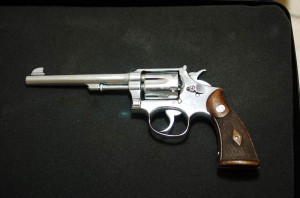
S&W model 1905 target
After handling the gun for a few minutes, the kid behind the counter told me that if it didn’t sell that week, the shop owner was going to hack-saw the barrel and make it into a “snubbie” because “they sell better”. I don’t know if that was true, or if he just saw me coming a mile away, but when I heard that, I instantly felt empathy for the little gun. I told him on the spot that I would allow no such thing to happen, and asked him to ring me up.
After bringing my new treasure home, I spent a little time cleaning it up and getting it ready for a leisurely life in the safe with the occasional range trip. After asking some folks about it who know a lot more about vintage S&W revolvers than I do, I learned that it was a model 1905 Target model, fourth variation, made in roughly 1915, the front sight had been modified, the grips were wrong, and they also confirmed that the gun had been refinished by someone other than the factory.
I ended up selling the grips, since they weren’t original anyways, and almost paid for the revolver with the proceeds. I put a set of 1970’s vintage Herret target stocks on, and pulled the side plate off to clean out some grit I could feel in the action. The double action trigger pull still isn’t perfect, but the single action is very nice, and that’s how I normally shoot the gun anyways.
I’ve shot the gun several times, and it does indeed deserve the reputation as an accurate gun. I loaded up some bullets from an early Geo A. Hensley #9 wadcutter mold over a light charge of bullseye, and they shoot as well as I can, and probably better. Average groups from a rest have been a little over 1″ at 25 yards.
I have been back to the pawn shop several times since then, and I have picked up a few other gems. I’ll write more about them later, but for now, here’s the old smith. I hope I’m as good looking and functional when I’m 98 years old!
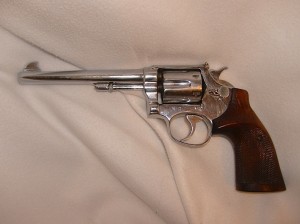
Updated model 1905 Target
Written on July 31, 2013
By Tony
in Machine Guns, NFA
I’ve wanted a machine gun since I was about 5 years old. For whatever reason, the timing and money never quite lined up for me to buy one until fairly recently. I spent a lot of time figuring out what I wanted, and trying to decide what I could afford. Eventually, I decided I wanted a Reising SMG. They don’t have the best reputation for reliability, but I tinker anyways, so I figured I’d take the chance on one. It took a little time to find the right deal, but I started the process of buying a Reising model 50 last September.
(For those of you who don’t know, NFA weapons, such as machine-guns, silencers, sawed off shotguns and other related things require a lengthy background check and a transfer tax to be paid. The process isn’t terribly difficult, but it is time consuming)
After many long months of waiting, my wife called me at the office one day in June to tell me that she had just signed for a package for me (Being C&R eligible, I had the gun transfer directly to me on my 03 FFL). Of course, I cut out of the office early and rushed home.
My wife stood there with me while I unwrapped layer after layer of bubble wrap, getting closer and closer to the object of desire.
Finally, I managed to get through all the layers, and pulled out my very own machine gun.
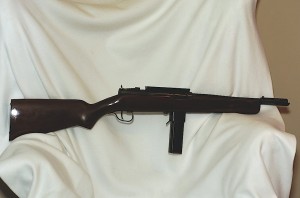
As things worked out, while this wasn’t my first NFA purchase, it is the first NFA device in hand. My other toys will be trickling in later in the summer or sometime in the fall (even though some of them were paid for months before the Reising…)
I had been doing my homework for some time on the gun, and within minutes of it’s arrival, I made some minor modifications to help with it’s long term reliability, most importantly, modifying the firing pin to act as an inertia pin.
The scope rail attached to the gun wasn’t something I was particularly excited about, but it made it more affordable, and I wouldn’t have to worry about the originality of the gun, and could treat it as a shooter. Since the gun had a rail, I decided I might as well use it. Looking through my collection of random optics for an appropriate red dot sight, I noticed a vintage low powered Weaver scope. I hadn’t thought of putting a scope on an SMG before, but heck this thing is more of a select fire carbine anyways… so I mounted the old Weaver K-2.5 micro-trac, just to see what it would look like.

It actually looked pretty good to my eyes, so I put it in the safe, and the next morning reluctantly left town for 4 days on a trip that had been planned months in advance. (I seriously contemplated bringing the gun with me on the trip and looking for a range while away, but the wife talked me out of it)
When I got back, I loaded the range bag with some ammo, various cleaning goodies, and my 3 magazines. One factory mag, and one Christie’s products mag came with the gun, and while I had been waiting, I had picked up another Christie mag. It was finally time to shoot.
This wouldn’t be my first time shooting a machine gun, but it was the first time shooting my own machine gun, and I was as excited as a kid on christmas morning. Despite that, I resisted the temptation to let loose right away, and fired the first magazine in semi auto to make sure everything was working as expected (firing pin) and to get the scope adjusted. I was impressed by the accuracy in semi auto mode; freehand shooting was producing groups with every hole touching at 25 yards.
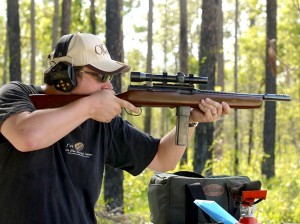
I was still concerned that the scope would make target acquisition more difficult than a red dot might, and that it would be harder to stay on target, so I brought a spare red dot with me, just in case I might need it. The range went cold after the first magazine, and we put up some fresh targets. After what must have been a few minutes, even though it felt like a half a day, the range went hot again, and it was time to push the selector forward, and see what would happen.
Needless to say, I was very pleased to be shooting my very own machine gun. I was even more pleased that I could stay on target very well with the scope, and target aquisition was better than expected. I wouldn’t need that red dot after all! After reading lots of horror stories about the reliability of the Reisings, I was relieved that it was running pretty well.
I discovered quickly that the magazines, you know, the ones that cost an arm and a half a leg? Well, they are quite finicky. The factory mag would feed the Lee 200 grain RF bullet, along with everything else I tried, but neither of the Christie mags would even think about feeding the RF. As a matter of fact, one of the Christie mags wouldn’t feed anything at all. I’ve since fixed that, and it’s as reliable as the other mags after some tweaking with pliers, a file and some sandpaper. The other Christie mag would feed RN profile bullets and SWC profile bullets fine. That suits me alright, as I cast a few styles of SWC, and generally prefer the profile anyways due to the nice clean holes they cut in the targets.
After my wife shot the gun, and between the two of us, we expended the rest of the ammo we brought with us (with varying degrees of functional reliability) we picked up our brass, packed up the car and headed home, where I spent at least an hour thoroughly cleaning the Reising. After getting it nice and clean, I nestled it back in the safe with several of the other C&R guns that I’ve had sent to me on my collectors license. I appreciated for a moment the irony that of the 4 guns I’ve ever bought using my C&R license, 3 of them are single shot boy’s rifles, and one is a machine gun.
After spending thousands of dollars on something like a machine gun, it’s easy to wonder if you made the right decision. After the first day shooting the Reising, there was no doubt in my mind that I had. At the moment, I’m saving up for my next MG purchase.
More to come on shooting the Reising and load development for reliability and accuracy.
A teaser of what the gun can do at 25 yards with a mag dump:

And at the same rang eon Semi-Auto:












